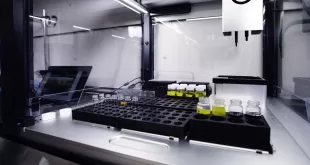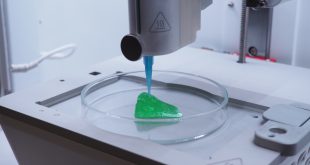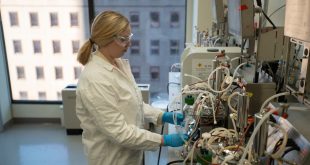Revolutionary 3D bioprinting technology helping to optimize the drug development process
By Sean tarry
The current and future state of drug discovery in Canada and across the globe is very much rooted in, and on the best of days reliant upon, innovation and scientific breakthrough. It’s an essential component on the journey toward affecting meaningful and medical revelations. And, one company that seems to possess the passion, drive, dedication and commitment necessary to continue pushing the boundaries of technological capabilities in order to positively impact the future of human health and wellness is VoxCell BioInnovations. In fact, according to Kevin Vos, the company’s Director of Business Development and Strategic Alliances, it’s on the verge of forever changing the way the drug development process works, for the betterment of all stakeholders involved.
“VoxCell BioInnovations is a tissue engineering company that uses 3D bioprinting technology to optimize the drug development process,” he explains. “Our specialty is in oncology and providing models for the development of therapeutics in cancer. We’ve done this by developing all of our own technology, serving as a bit of a one stop shop in 3D bioprinting tissue engineering. We actually developed Canada’s first high resolution 3D bioprinter which has such high resolution that its ten-times higher than the smallest blood vessel in the human body, allowing us to create extremely detailed tissue models. And, we combine that high resolution 3D bioprinter with our own biologics, making the inks in-house, customizing them to be tissue-specific. If we want to study breast cancer, we make sure that the tissue model we create matches the chemical composition and mechanical properties of a breast tumour. We then combine that with our own vascularisation software that enables us to custom design what the vasculature is going to look like.”
Multidisciplinary team
The work that VoxCell BioInnovations are currently undertaking could potentially prove to pave the way forward when it comes to the development of human tissue models made specific. What’s more important, however, is the fact that, by facilitating a near-perfect confluence of science, technology and human understanding, the team at VoxCell BioInnovations is creating artificial biopsy samples for drug screening and therapeutic development, optimizing the drug development process and providing a platform from which better clinical insights can be gained. And, to pull this type of achievement off, the team, explains Vos, needs to be multidisciplinary and possessing a collaborative spirit.
“It’s really important that the work we do at VoxCell is approached with a holistic perspective and mindset,” he says. “We have a number of different scientists who all understand the cancer microenvironment and how a tumor interacts with things, informing the design of the model in order to make it as human-like as possible. We have biomedical engineers who actually operate the printer, executing the tissue printing. We also have hardware engineers who are the people who actually build and maintain the printers, executing all of the prototyping, including the building of our profusion chambers, which are microfluidic devices that our tissues sit in. And we’ve got our software team as well. There are a number of different expertise required within the company to create these models, and a host of really great talent that’s come together to make it happen.”
More predictive tools
And make it happen, VoxCell BioInnovations certainly does, quickly transforming the drug development process, shortening the time that it takes for the potential efficacy of drugs to be identified. And, the work that the company’s doing is also helping to save developers and researchers money. In North America, about $60 billion US is being spent each year on failed trials just in oncology. And, according to Vos, by providing more predictive tools, the efficiency of scientists is enhanced, and the chances of achieving success, quicker, increase.
“What we’ve seen over the course of the past 10 or 15 years within the area of drug development is a definite rise in the need for more human-like, more predictive preclinical tools.” he asserts. “We’re currently seeing 95 per cent of all drugs fail within the traditional drug development process. And, too many of them are deemed failure too late, after they’ve been injected into humans. With bioprinting, we’re not going to see a change to the fact that 95 per cent of drugs fail to make it to market. But, by introducing human-like models that can be tested on and created patient-specific, we’ll be able to identify failures earlier in the development process, allowing companies a higher chance of success for the drugs that are taken forward to clinical trials, saving the time it takes to develop life saving therapeutics, while also reducing the associated costs that are required in doing so.”
Creating positive impact
These are some of the ways by which VoxCell BioInnovations is attempting to create a positive impact within the field of oncology and support improvements to the world of drug development and testing. However, in order to have access to the financial wherewithal that startups and other businesses need in order to grow and succeed, investment is required. In fact, from Vos’ point-of-view, aside from the groundbreaking work that the company does, there aren’t many things that are more important than investing partners.
“Investments mean everything with respect to supporting the work that we do,” he says. “We’re sort of the first company involved in this bioprinting vascularized cancer tissue model space. And it always seems to be a little more challenging when you’re bringing something brand new to the market. There’s always going to be a little bit of skepticism and a need to actually see innovation work. So, building meaningful partnerships is incredibly important to us. We currently have one ongoing here in BC with the BC Cancer Agency and have about eight projects scheduled for 2024 and early 2025 to really help validate our technology and start working on therapeutic development for some biopharmaceutical companies.”
Global standard
It’s all very impressive progress made by such a young company. But, in speaking with Vos, it definitely doesn’t seem as though VoxCell BioInnovations has any plans on slowing any time soon. In fact, he suggests that there are still quite a few possibilities and potential for growth remaining going forward.
“With the diversity of our technology, there’s a lot of different directions that we can go. But in the next one to three years, what we’re really focused on becoming the sort of global standard in creating 3D cancer models for therapeutic development. Down the road, we have our eye on the personalized medicine side of things and helping individual patients make decisions based on the therapeutics that work best for them. But, for now, we’re intent on continuing to develop our customized tissue models and, as a result, lending to streamline the drug development process and making it more efficient going forward.”
 BioLab Business Magazine Together, we reach farther into the Canadian Science community
BioLab Business Magazine Together, we reach farther into the Canadian Science community





